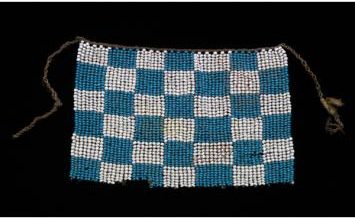
Cache-sexe Zulu, late 19th-early 20th century, held by National Museum of African Art, Gift of William F. Brodnax III, Object Number: 99-6-20.
What if you could tell your gender age and marital status just from your clothes?
Well, in most cultures, you can. What we wear tells the rest of our communities what our exact place is within it. In much of sub-Saharan Africa, modesty norms are very different to those prescribed to Western cultures. Wearing next to nothing in such a hot climate is not a sign of promiscuity, but garments like the cache-sexe or “modesty belt” say a lot about the wearer’s culture.
The term cache-sexe was used by the French, so it comes up in those areas of Africa colonized by the French. There are many other terms used. This small beaded apron-like garment is from the KwaZulu-Natal area of South Africa. It covers the pubic area of girls’ bodies and is worn by girls throughout Africa.
Its beads are very precious and have symbolic meanings. In Zulu culture, they are often given when girls are babies. A girl will add beads to her apron over the years, so the longer it is, the older she is. This one was worn by a very young, unmarried girl. The beads are glass, which would have been very highly prized. They can also be made of other materials, like wood, shell, animal teeth, seeds, clay, and brass.
The cache-sexe has been worn for millennia. It is both practical and contextualizes a girl in her community, telling all about her maturity status. In some cultures, girls begin to wear them after they get their first period. She does not have much control over wearing it, but she can create the apron she wishes by choosing which beads to string. They are her beads and she can communicate different things by the designs and styles she chooses. It is an exclusively female garment, thus contains some spiritual meanings as well. Some beads, especially those made of brass, can contain talismans and be protective of the girls wearing them.
-Ashley E. Remer
Head Girl
Girl Museum Inc.
This post is part of our 52 Objects in the History of Girlhood exhibition. Each week during 2017, we explore a historical object and its relation to girls’ history. Stay tuned to discover the incredible history of girls, and be sure to visit the complete exhibition to discover the integral role girls have played since the dawn of time.
